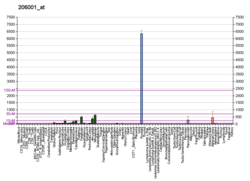| Identifiers | |
|---|---|
| CAS Number | |
| ChemSpider |
|
| UNII | |
| ChEMBL | |
| CompTox Dashboard (EPA) | |
| Chemical and physical data | |
| Formula | C190H287N55O57 |
| Molar mass | 4253.714 g·mol−1 |
| | |
Neuropeptide Y (NPY) is a 36 amino-acid neuropeptide that is involved in various physiological and homeostatic processes in both the central and peripheral nervous systems. It is secreted alongside other neurotransmitters such as GABA and glutamate.[5][6][7][8]
In the autonomic system it is produced mainly by neurons of the sympathetic nervous system and serves as a strong vasoconstrictor and also causes growth of fat tissue.[9] In the brain, it is produced in various locations including the hypothalamus, and is thought to have several functions, including: increasing food intake and storage of energy as fat, reducing anxiety and stress, reducing pain perception, affecting the circadian rhythm, reducing voluntary alcohol intake, lowering blood pressure, and controlling epileptic seizures.[8][10]
- ^ a b c GRCh38: Ensembl release 89: ENSG00000122585 – Ensembl, May 2017
- ^ a b c GRCm38: Ensembl release 89: ENSMUSG00000029819 – Ensembl, May 2017
- ^ "Human PubMed Reference:". National Center for Biotechnology Information, U.S. National Library of Medicine.
- ^ "Mouse PubMed Reference:". National Center for Biotechnology Information, U.S. National Library of Medicine.
- ^ Heilig M, Widerlöv E (1995). "Neurobiology and clinical aspects of neuropeptide Y". Critical Reviews in Neurobiology. 9 (2–3): 115–136. PMID 8581979.
- ^ Decressac M, Barker RA (December 2012). "Neuropeptide Y and its role in CNS disease and repair". Experimental Neurology. 238 (2): 265–272. doi:10.1016/j.expneurol.2012.09.004. PMID 23022456. S2CID 15088613.
- ^ Robinson SL, Thiele TE (2017). "The Role of Neuropeptide y (NPY) in Alcohol and Drug Abuse Disorders". The Role of Neuropeptides in Addiction and Disorders of Excessive Consumption. International Review of Neurobiology. Vol. 136. pp. 177–197. doi:10.1016/bs.irn.2017.06.005. ISBN 9780128124734. PMID 29056151.
- ^ a b Tatemoto K (2004). "Neuropeptide Y and Related Peptides". In Michel MC (ed.). Neuropeptide Y: History and Overview. Handbook of Experimental Pharmacology. Vol. 162. Springer. pp. 2–15. ISBN 9783540405818.
- ^ Kuo LE, Kitlinska JB, Tilan JU, Li L, Baker SB, Johnson MD, et al. (July 2007). "Neuropeptide Y acts directly in the periphery on fat tissue and mediates stress-induced obesity and metabolic syndrome". Nature Medicine. 13 (7): 803–811. doi:10.1038/nm1611. PMID 17603492. S2CID 25675166.
- ^ Colmers WF, El Bahh B (March 2003). "Neuropeptide Y and Epilepsy". Epilepsy Currents. 3 (2): 53–58. doi:10.1046/j.1535-7597.2003.03208.x. PMC 321170. PMID 15309085.





